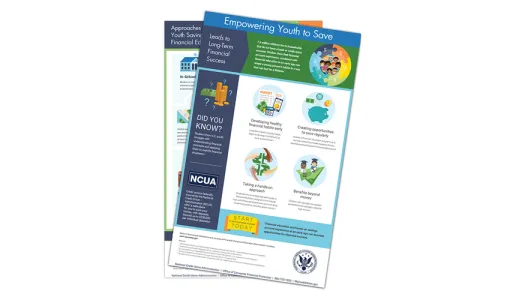Empowering Youth To Save

Leads To Long-Term Financial Success
7.6 million children live in households that do not have a bank or credit union account. Studies show that financial account experience, combined with financial education at an early age can shape a young person’s habits in a way that can last for a lifetime.1
Developing healthy financial habits early
Long-term healthy money habits begin to develop in childhood, as early as preschool.2
Creating opportunities to save regularly
Access to financial education programs and savings accounts provides opportunities to develop positive long-term financial behaviors.3
Taking a hands-on approach
Students who at an early age participate in financial education programs that include real-world financial experiences are more likely to develop positive attitudes about money.3
Benefits beyond money
Children with savings have greater expectations for education beyond high school.4
Did You Know?
- Studies show U.S. youth struggle with understanding financial concepts and applying them to real-life financial situations.5
- Credit unions federally insured by the National Credit Union Administration (NCUA) offer a safe place for you to save your money, with deposits insured up to $250,000 per individual depositor.
Start a Youth Savings Account Today
Financial education and hands-on savings account experience at an early age can increase opportunities for financial success.
Approaches To Youth Savings and Financial Education
Youth savings and financial education programs can help reinforce positive behaviors that can help young people become financially capable adults.6
In-School Branches
Student-run credit union or bank branches inside schools that offer students basic savings accounts.
Classroom Presentations and Workshops
Classroom activities and lessons focused on healthy financial habits.
Lessons Learned at Home
Children learn from watching parents or caregivers earn, shop, save and borrow. Parents can talk to children about creating positive money habits and can reinforce lessons learned at school through at-home activities such as saving money in piggy banks, making spending choices (real or pretend) and playing interactive games together.
Reality Fairs
Simulate "the real world" with a hands-on, interactive approach to learning. Participants choose a career path and receive a corresponding salary which they must then use to balance a budget while making simulated real world financial decisions (e.g. buying or leasing a car, life insurance, owning or renting a home).
Community-Led Savings Programs
State and local governments, as well as non-profit organizations, help youth save for post-secondary education through youth savings programs, such as 529 Plans or school district-wide savings opportunities.
Youth Savings Accounts
Accounts designed for youth have account terms and conditions explained in an age-appropriate manner and feature no minimum or starting balance, zero or low monthly fees, free access to online/mobile banking, and free and unrestricted use of in-network Automated Teller Machines (ATMs).
Free Resources
For free resources and more information available to help support youth savings habits
visit MyCreditUnion.gov, Money Smart, Money As You Grow and MyMoney.gov 7
Many of the sources listed below are courtesy of Financial Literacy and Education Commission members. www.mymoney.gov
Sources:
1 FDIC National Survey of Unbanked and Underbanked Households (2015) - Federal Deposit Insurance Corporation
2 Youth Personal Finance Pedagogy (2016) - Consumer Financial Protection Bureau
3 Assessing Financial Capability Outcomes (AFCO) Youth Pilot (2014) - U.S. Department of the Treasury
4 Scholarly Research on Children’s Savings Accounts (2014) - Prosperity Now
5 Programme for International Student Assessment (2015) - Organization for Economic Co-operation Development
6 Linking Youth Savings with Financial Education: Lessons from the FDIC Pilot (2017) – Federal Deposit Insurance Corporation
7 MyCreditUnion.gov, NCUA.gov, Money Smart, Money As You Grow, MyMoney.gov